How To Set Time In Pioneer Car Audio System
Crossovers arecrawly for getting better sound from even inexpensive speakers. But what are crossovers, how are they helpful, and what are the best crossover settings for car audio?
In this article I'll show you how to set crossover frequencies for your car audio system along with some other helpful info:
- How crossovers work andwhy they make a large difference
- The all-time machine sound crossover frequency settings (table is provided)
- Diagrams to show you how to set your car amp crossovers
…and much more than, too. There's a lot to cover so let'southward get started!
Contents
- What does a crossover exercise? Crossover frequency, slopes, and more than explained
- How are crossovers helpful for speakers?
- Understanding crossover nuts
- What are the 3 types of crossovers in car sound?
- 1. Agile (electronic) crossovers
- ii. Passive (speaker) crossovers
- What are skilful crossover frequencies for car audio?
- Recommended crossover frequency tabular array
- How to set the crossover frequency for speakers on your amp
- How to set high pass filter options on your amp (for main speakers)
- How to set subwoofer crossover frequency options
- What crossover slope do I need? Does it brand a divergence?
- Why do some electronics offer more crossover slopes?
- More than great speaker and crossover info to see
What does a crossover exercise? Crossover frequency, slopes, and more than explained
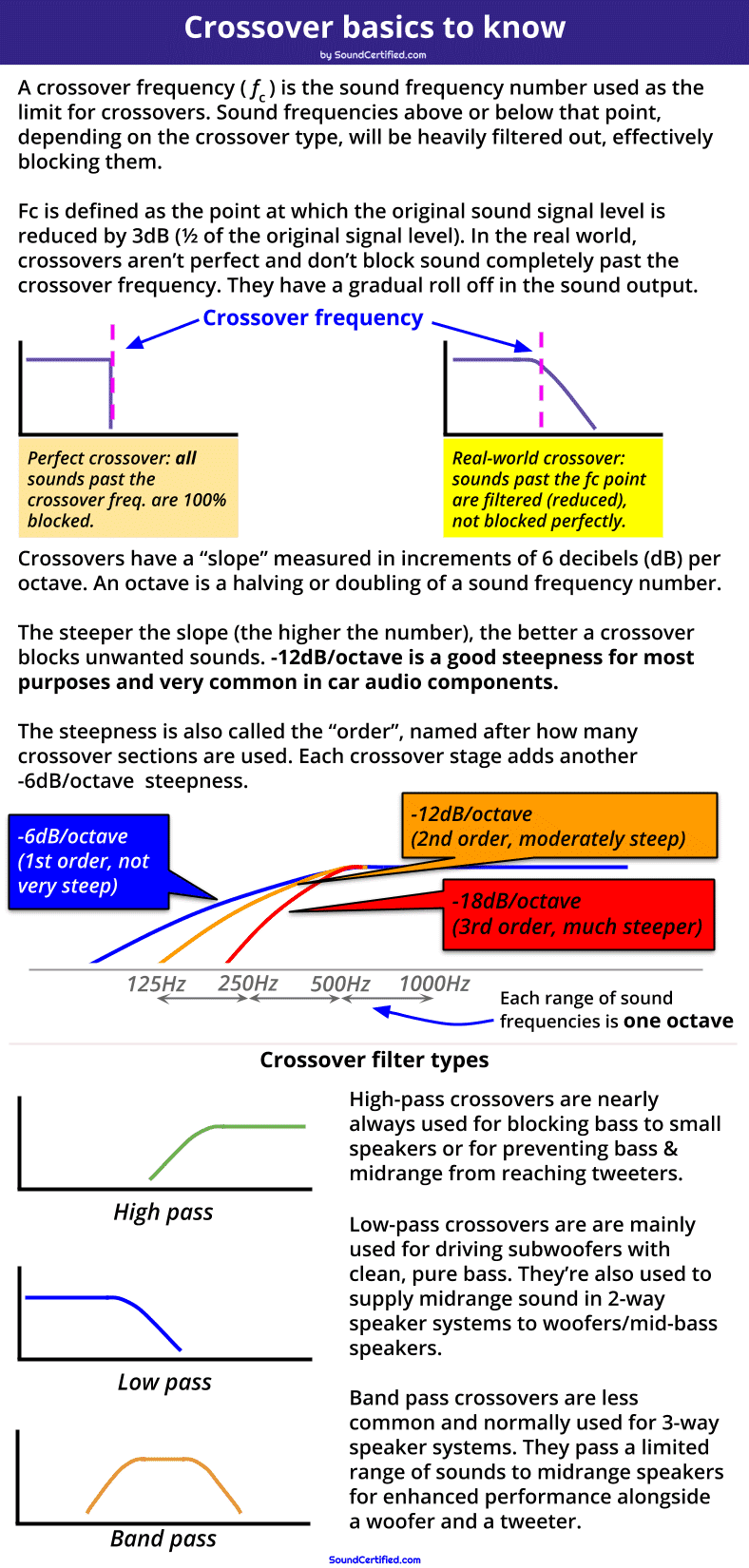
People tend to talk almost crossovers equally if they totally "cake" sounds you lot don't want to go to your speakers. While they sort-of do, in reality, crossovers are filters that greatly reduce the amount of unwanted sound frequencies sent to speakers.
How are crossovers helpful for speakers?
Crossovers arevery important for automobile audio as they help u.s. deal with the poor enclosures they're used in forth with the weaknesses that small-scale speakers have. Some of the well-nigh common speaker sizes installed from the factory or sold for aftermarket use similar three.5″, 4″, and v.25″ sizes can exist terrible for playing bass, resulting in bad audio and ugly distortion.
To brand matters worse, speakers in cars, trucks, and even boats are often mounted in areas where information technology'southwardimpossible to get great sound considering they leak air and don't form a adept enclosure to deliver sound properly unlike dwelling stereo speaker cabinets. That means they leak air desperately and tin "bottom out" hands if driven hard with bass sounds, for case.
One reason why crossovers are so helpful at that place is that we can use them to block terrible-sounding sound frequencies that ordinarily would cause these problems and others, too.
Agreement crossover basics
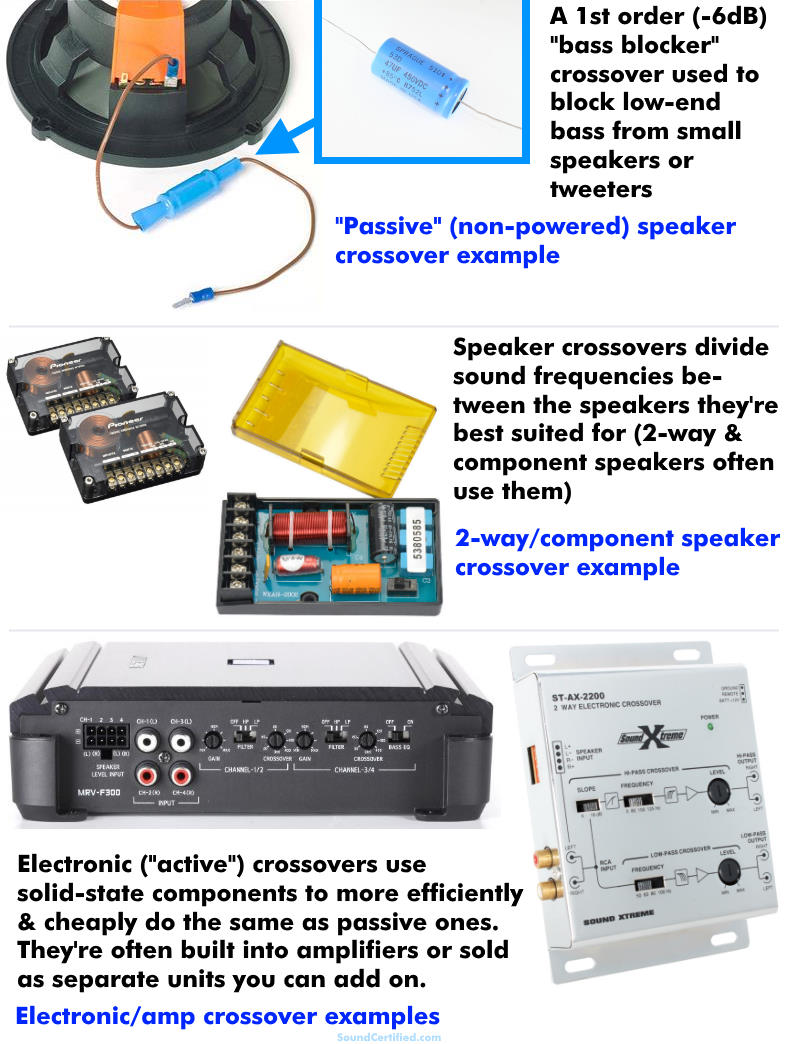
When we think most musical signals we don't always realize the of import things going on behind the scenes. In fact, you'll almostnever find a proficient-sounding speaker system that isn't using 1 or more types of crossovers; that's how important they are for corking sound.
A crossover (sound crossover) is an electrical or electronic component circuit made upwards of parts that react to certain frequencies and designed to eliminate unwanted ranges of sound from reaching speakers.
Crossovers allow a desired range of sound to pass unaltered and effectively cake ranges of sound past a limit called the cutoff frequency.
A crossover circuit tin can be used for but one single speaker channel or combined with another to dissever and direct audio the best speakers suited to produce it. In automobile sound, the most common speaker crossovers are used in two-style coaxial and component speakers.
Simple speaker crossovers tin can likewise be added inline with speakers to block lower-stop bass as well.
What are the 3 types of crossovers in car audio?
There are three types of crossovers:
- Active (electronic) crossovers – work in the signal path (line-level signals)
- Passive (speaker) crossovers – piece of work in the amplified speaker path afterward an amplifier
- Digital (software) crossovers – they piece of work with sound in the digital music domain
1. Active (electronic) crossovers
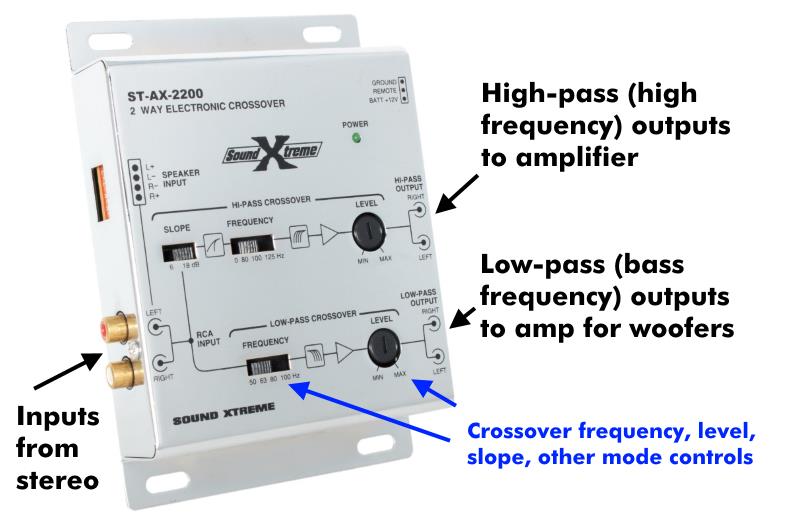
An example of an external (add-on) electronic (active) 2-mode crossover. These are basically the same every bit the electronic crossovers congenital into many amps yous can purchase today. Some offering a few more options, but unlike years gone past, they're less and less important these days. Almost amps today include what yous'll need already.
Active crossovers employ electric components such as transistor-based chips chosen op-amps (operational amplifiers) to acquit the same manner as their much bigger and much less efficient speaker crossover counterparts.
They offer a lot of benefits (particularly their compact size) and tin can be designed to allow you lot to choose between using no crossover, a high-laissez passer, or a low-pass hands. Unlike passive crossovers, they exercise crave power to work and change the indicate, hence the name "active."
Active crossovers work with a line-level (RCA) bespeak either before an amp's RCA inputs (in addition external crossovers you tin buy) or inside the amp. The signal output of an electronic crossover has to be amplified, dissimilar speaker (passive) crossovers that you connect betwixt an amp and speakers.
2. Passive (speaker) crossovers
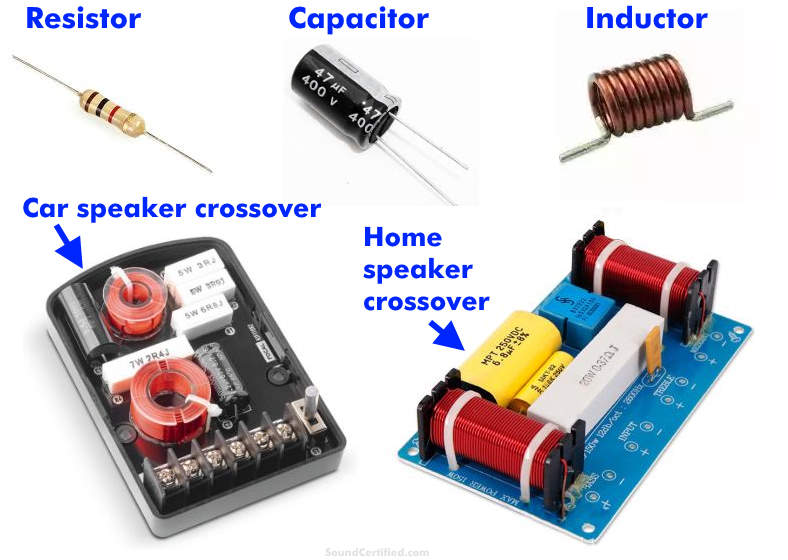
"Passive" crossovers are those that utilize inductor and capacitors, without a ability source, to filter out sounds you don't desire to reach speakers. They're usually used for smaller speakers similar with tweeters, ii-way coaxial speakers, and component speaker systems because they're relatively affordable in those situations.
Passive speakers aren't used to block midrange and treble ("highs") from subwoofers because the size of the inductors needed would exist actually big – and expensive, besides! They're besidesmuch less efficient than electronic ones in that case.
That's one reason the built-in low-pass subwoofer crossovers in amps are so great.
three. Digital (software-based) crossovers
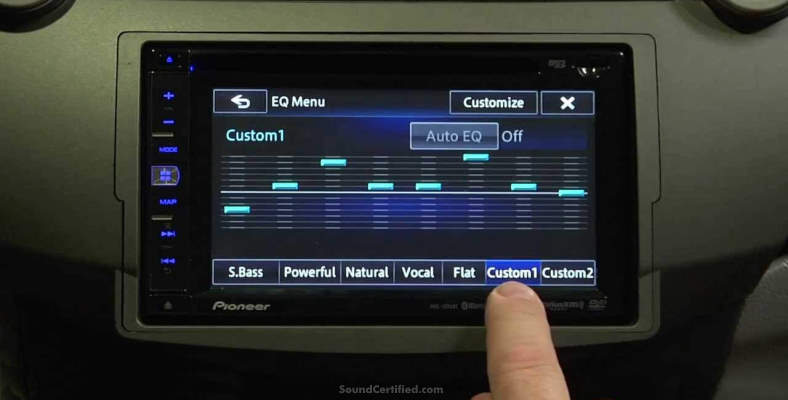
Software-based equalizers and crossovers use avant-garde software routines to alter sound in the "digital domain." That means they can alter the sound (or filter information technology, equally crossovers practise) by working but with the digital musical signal. This makes them more complicated simply saves spaces & money since information technology reduces size & the electronics required.
This type is implemented in the software code of home theater receivers, machine stereo head units, or digital sound processors. Software-based crossovers usually work by implementing math-based functions that alter the signal output based on its frequency.
Information technology's aactually complicated topic, but the basic concepts aren't hard to sympathise. Past using special formulas, not only different types of crossovers but too equalizers can be implemented and operate on the musical bespeak when its represented as a binary digital number.
This is a toll and infinite-saving feature as there are few, if any, parts needed to make it piece of work. However, it ordinarily takes more specialized microprocessors or digital signal processor (DSP) chips to do so.
What are good crossover frequencies for car audio?
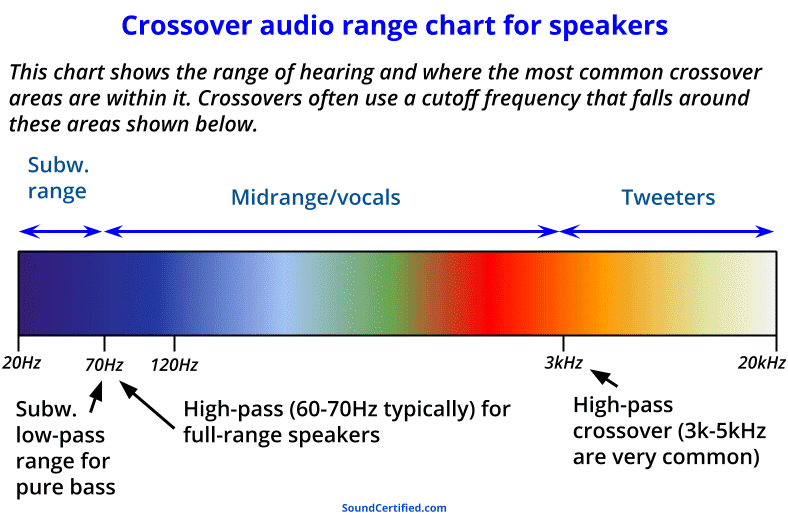
Within the range of sound your ears can hear, for most cases crossover frequencies typically fall into a small range you'll likely use for tweeters (high-pass), full range speakers (high-pass), and subwoofers (depression-pass).
The truth is, there's not a "perfect" fix of crossover frequencies that work for every speaker in every vehicle. That's basically impossible considering nigh everyone is using different speakers, a different setup, and so on.
Notwithstanding, here are some of the most common frequencies that piece of work well in many cases.
Recommended crossover frequency tabular array
| Speaker/System Type | Crossover Freq. & Type | Notes |
|---|---|---|
| Subwoofers | seventy-80 Hz (low pass) | Proficient low-pass frequency range for subwoofer bass & blocking midrange sounds. Best for pure, clear bass audio that "hits." |
| Car primary (full range) speakers | 56-60Hz (high pass) | Blocks low-end bass that causes distortion or speakers to "bottom out." Groovy compromise between full-range sound and midrange bass capability. |
| Tweeters or ii-way speakers | iii-3.5KHz (high laissez passer, or loftier/low-pass) | Well-nigh 2-fashion or 1-way (tweeter) crossovers use a frequency virtually this equally most tweeters can't handle sounds below this range. Aforementioned for woofers in a higher place this range. |
| Midrange/woofer | 1K-iii.5KHz (low pass) | Woofers and many midrange speakers do not perform well higher up this full general range. They're poor for treble and a tweeter should be added. |
| three-way system | 500Hz & 3.5KHz (Woofer/tweeter crossover points) | Like to ii-manner systems the upper freq. would be the same. Midrange drivers in a 3-way system oftentimes exercise not perform well below 500Hz or 250Hz in many cases. |
How to set the crossover frequency for speakers on your amp
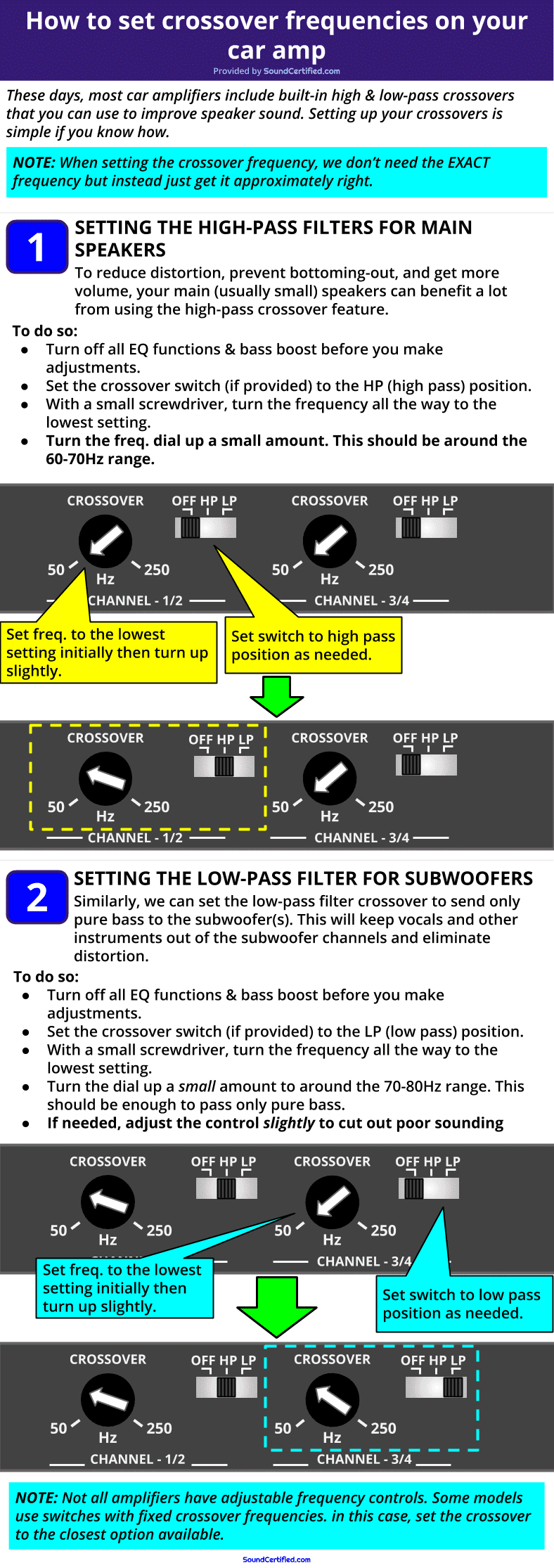
How to set high pass filter options on your amp (for principal speakers)
Virtually people typically use a car amplifier for one of a few basic systems:
- Driving front and rear full range speakers, no subwoofer
- Driving forepart and rear full range speakers plus a subwoofer
- Driving a subwoofer
For cases #1 and 2, if your amplifier has a built-in crossover option you can use the loftier laissez passer crossover to block depression end bass that small speakers only can't produce well, if at all. The terminate effect is that y'all'll exist able to drive your primary speakers with more volume and lower distortion.
We only want to cake that certain range of bass that subwoofers can handle. We don't want to cake bass found in the lower stop of midrange like from the vocals in music (for instance, around 100-120Hz or so). lx to 70Hz or so are pretty mutual crossover frequencies that usually work well.
Adjusting an amp's loftier pass crossover
For amplifiers with adaptable crossovers, employ the following steps:
- Turn off equalizer or bass boost functions
- Prepare the front aqueduct or front and rear (if using both) crossover switches to "HP" or however they're labeled for the high pass role.
- Adjust the crossover frequency control to the lowest setting (this is usually around 50Hz for most amps).
- Using a small screwdriver, turn it upslightly– virtually ane/8 of a turn. This should be around the 60-70Hz range.
Notation: Non all amplifiers offer an adaptable control. Some (especially ultra-compact models) utilise fixed frequencies and switches but. In that case, effort using the switch position closest to the 60-70Hz loftier pass frequency range.
How to fix subwoofer crossover frequency options
Similarly, exercise the following to adjust the subwoofer frequency & crossover:
- Turn off equalizer or bass boost functions
- Prepare the crossover switch to "LP" or however it'due south labeled for the depression pass
- Conform the crossover frequency control to the lowest setting (this is commonly around 50Hz for most amps).
- Using a pocket-sized screwdriver, turn it upslightly– about 1/8 of a turn. This should exist around the 70Hz range
- Arrange as needed: if yous're non happy with the low-end range (the range of bass sound produced), don't be afraid to accommodate the frequency control a bit.
TIP: With decent power and a good speaker enclosure properly matched to the sub, you should have clean, pure bass at this bespeak.
However, I've seen many cases where a subwoofer installed in the wrong type of subwoofer enclosure produces bland, poor audio. A crossover tin't ready that problem.
What crossover slope do I need? Does it make a difference?
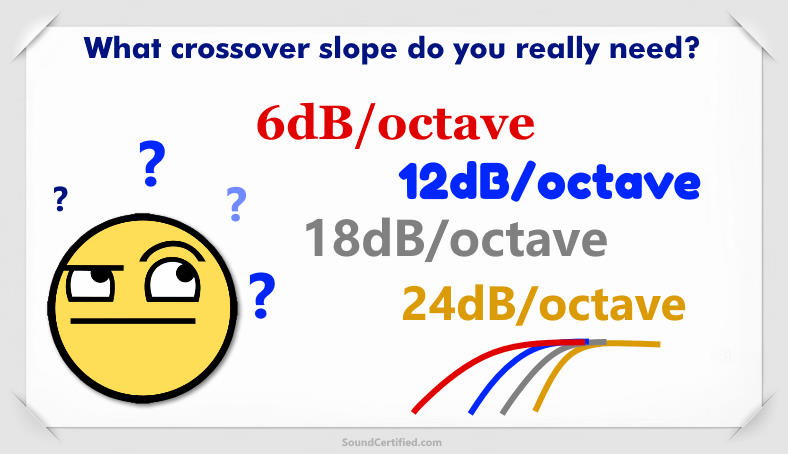
In some cases, you'll be able to choose from a number of crossoverslopes (the steepness of the cutoff) on your amplifier or other components. As I mentioned earlier, the slope how constructive a crossover is at allowing fewer unwanted sounds to reach your speakers, with higher numbers being more constructive.
And as I mentioned ealier, -12dB per octave ("-12dB/octave") is very mutual in car audio. While it may seem like the dominion of "more is better" applies here, the truth is thatmost of the time a 12dB or 18dB/octave crossover gradient is all you'll need.
Why do some electronics offer more crossover slopes?
Some amps, head units, and digital processors/equalizers for car audio offering more than crossover options for people who want advanced control – especially if yous're working on a high-end sound system. For example, when bi-amping speakers (using an electronic crossover and separate amp channels for the tweeter, the midrange speaker, and then on), yous can accept advantage of each speaker's natural behavior and go super-detailed control over the signals yous transport to them.
That'southward a much more advanced topic and worth its own commodity, by the way.
Notwithstanding here are the basic rules for crossover slopes that will work for 90% of people:
- A 12/dB setting is good and will do the job in virtually cases for subwoofers (low-pass) and full-range speakers (high-pass).
- However, 18dB/octave tin be better for some subwoofers depending on your item subwoofer, the enclosure, and how your vehicle alters the audio. In that case, experiment using the -18dB setting and run across how it sounds.
- 6dB/octave is a flake poor and will allow sounds to pass that can "muddy" the sound and just isn't skilful enough for bass speakers. I don't recommend that in near cases.
Most of the time, the main goal is to have the same cutoff at the same frequency. The goal, in perfect conditions, is that the speakers friction match up but right so there's not much overlap in their sound besides as no gaps in the audio.
However, information technology's definitely alot harder in the existent world. In my feel, however, 12dB/octave works well and is effective enough to brand a big divergence in how your system sounds.
More great speaker and crossover info to see
Check out my other great manufactures you'll love:
- Desire to larn more? Hither'due south what crossovers practice and how they piece of work.
- Here's a detailed guide to how speakers work
- Acquire what happens if you employ a different impedance speaker with a crossover.
- Wondering about speaker Ohms? Find out here what car speaker impedance is all nigh.
Got any questions I can assistance with or suggestions? Leave a annotate below or sent a message via my Contact folio. Thanks!
How To Set Time In Pioneer Car Audio System,
Source: https://soundcertified.com/how-to-set-crossover-frequency-for-car-audio-system/
Posted by: morenoentils1983.blogspot.com


0 Response to "How To Set Time In Pioneer Car Audio System"
Post a Comment